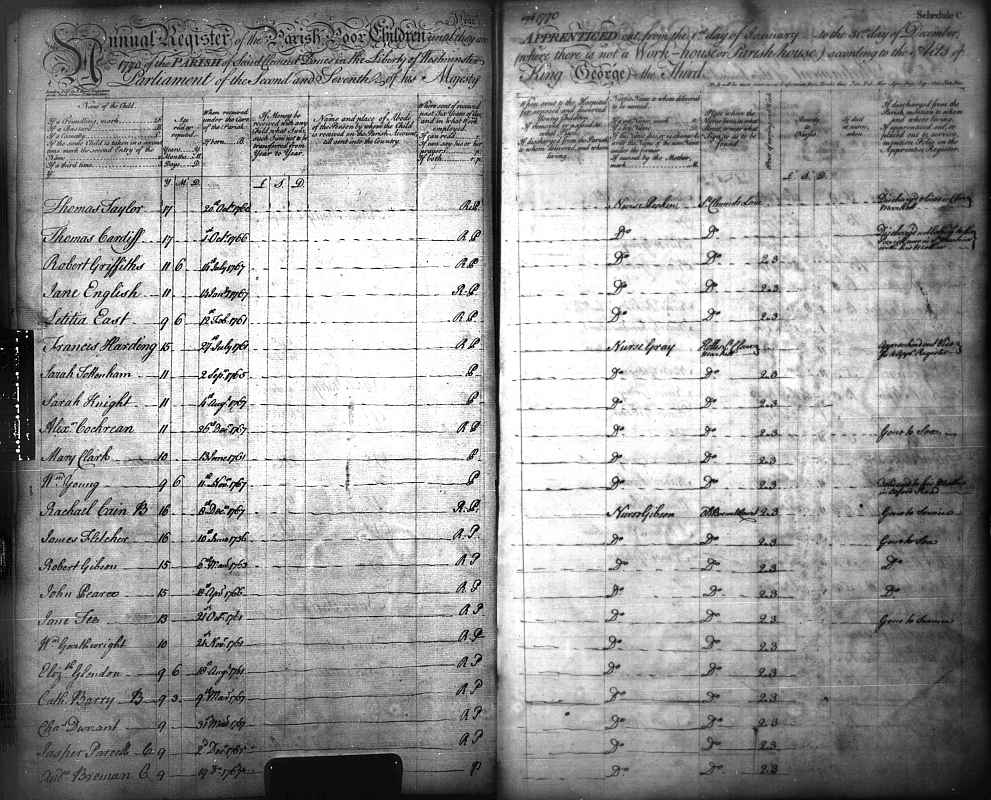Registers of Poor Children under Fourteen years in Parish Care (RC)
 St Clement Danes, Annual Register of Parish Poor Children, 1767-1786, Westminster Archives Centre, Ms B1257, LL ref: WCCDRC365000037&8.
St Clement Danes, Annual Register of Parish Poor Children, 1767-1786, Westminster Archives Centre, Ms B1257, LL ref: WCCDRC365000037&8.
Introduction
As a direct result of the campaigning of Jonas Hanway, An Act for the keeping regular, uniform and annual Registers, of all Parish Poor Infants under a certain Age was passed by Parliament in 1762.1 It stipulated that parish officers within the Bills of Mortality (the City of London, urban Middlesex, Westminster and Southwark) should keep a precise register of all children in parish care under the age of four years, and that an annual summary of these registers should be published by the Worshipful Company of Parish Clerks. This act legislated for the creation of the registers reproduced here, and stipulated the size ("Royal Paper", 25" x 20"), layout and content of each register. It also stipulated that the registers should be approved annually by the vestry, and laid down a series of fines for failure to comply.
In a further Act for the better Regulation of the Parish Poor Children, passed in 1767,2 the registers were extended to include children up to the age of fourteen, and the creation of a separate Register of Parish Apprentices (RA) was mandated. This second act also required that London parishes put their children to nurse in the countryside at least three miles from London. However, the 1767 Act excluded the ninety-seven parishes within the City of London, along with four Westminster parishes, from its provisions, leaving the parish of St Dionis Backchurch subject to the provisions of the 1762 act alone. As a result, the equivalent register for the parish of St Dionis Backchurch has been categorised as a Register of Infants rather than under this (RC) category.
Layout and Content
These acts of parliament included a series of schedules that listed the information to be provided. The 1762 act included two separate schedules of register designs (A and B), the first for parishes which used a workhouse, and a second for those without a workhouse.
All the Registers of Poor Children included on this website are laid out either according to schedule A of the 1762 act, or after 1767, schedule B of the later act. The slightly more extensive schedule B of the 1767 Act includes the following information:
- The name of the child
- If a foundling, bastard or casual
- If the same child has been taken in more than once
- Their age - years, months, days since birth
- If they were born in the workhouse or when admitted
- Name of the officer, or parent who sent them
- If money was received with the child
- If the child died in the workhouse or was discharged, and by whom they were nursed
- What work children over six years were engaged in
- If the child could read and say their prayers
- If they had been sent to the Foundling Hospital
- If discharged, to whom and where they were living
- If removed or passed, to what place
- The child's nurse's name, and if a wet or dry nurse
- If nursed by the mother
- The address of the nurse
- The amount paid for nursing per week
- The nature of any rewards given to nurses
- If the child had died at nurse and when
- For children over six, if and when they were brought back to the workhouse
- If discharged from the house, to whom and where living
- If apprenticed, on what folio of the Register of Apprentices (RA) they appear.
The details included in the registers created under schedule A of the 1762 Act can be seen in the Registers of Infants (RI).
The detailed and complex nature of the information required ensured that pre-printed registers were soon available for the use of parish clerks, and the examples reproduced on this website were all the product of a single printer/engraver, a T. Major, who at different times gives his address as either No 3. Tavistock Row, Covent Garden, or "on the paved stones, St Martin's Lane".
These registers take the shape of a table spread across two pages, with the child's name in the left hand column. Because this text is difficult to read in transcribed form, you are advised to consult the associated original page images.
Introductory Reading
- Taylor, James Stephen. Jonas Hanway, Founder of the Marine Society: Charity and Policy in Eighteenth-Century England. London and Berkeley, 1985, ch. 8.
- George, M. Dorothy. London Life in the Eighteenth Century. 1925, 1965, pp. 58-60.
Online Resources
For further reading on this subject see the London Lives Bibliography
Documents Included on this Website
- St Botolph Aldgate, Register of Poor Children, 1769-79, London Metropolitan Archives, Ms. 2655/1, LL ref: GLBARC10800, Tagging Level: C
- St Botolph Aldgate, Register of Poor Children, 1780-91, London Metropolitan Archives, Ms. 2655/2, LL ref: GLBARC10801, Tagging Level: C
- St Botolph Aldgate, Register of Poor Children, 1792-1800, London Metropolitan Archives, Ms. 2655/3, LL ref: GLBARC10802, Tagging Level: C
- St Botolph Aldgate, Register of Poor Children, 1762-66, London Metropolitan Archives, Ms. 2656, LL ref: GLBARC10803, Tagging Level: C
- St Botolph Aldgate, Register of Poor Children, 1774-86, London Metropolitan Archives, Ms. 2657/1, LL ref: GLBARC10804, Tagging Level: C
- St Botolph Aldgate, Register of Poor Children, 1788-1802, London Metropolitan Archives, Ms. 2657/2, LL ref: GLBARC10805, Tagging Level: C
- St Clement Danes, Annual Register of Parish Poor Children, 1767-86, Westminster Archives Centre, Ms. B1257*, LL ref: WCCDRC36500, Tagging Level: C
Back to Top | Introductory Reading
Footnotes
1 2 George III c. 22. ⇑
2 7 George III c. 39. ⇑